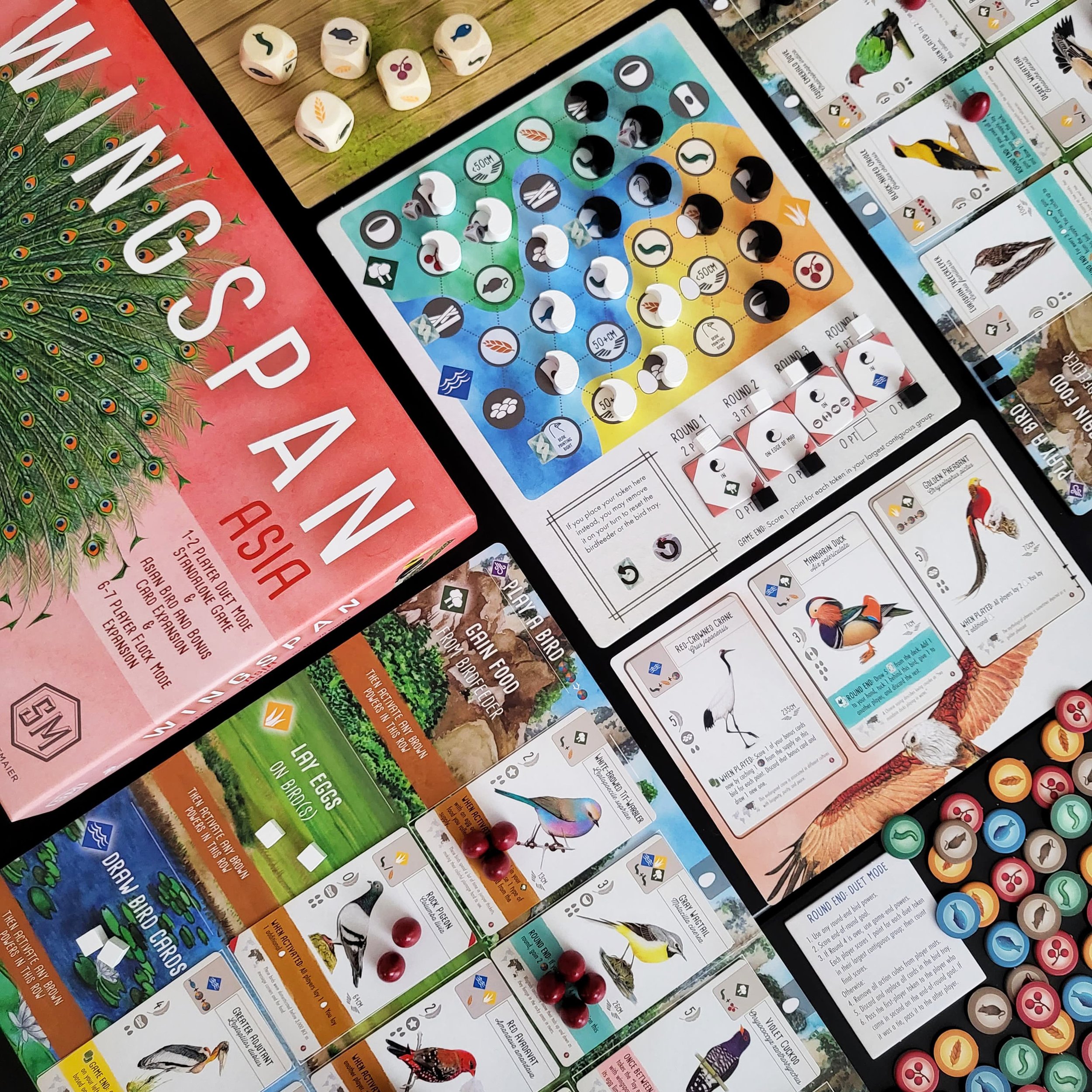Designed by Elizabeth Hargrave and published by Stonemaier Games in 2019, Wingspan received many accolades and is one of the most beloved modern board games. This year, the first stand-alone expansion, Wingspan: Asia, hits the market. Aside from introducing us to 90 new Asian bird species, it also features 2 new game modes - DUET mode for 2 players and FLOCK mode for 6-7 players. We will cover a few basic strategies for DUET mode in this article.
Opening Hand and Bonus cards
Just like the base game of Wingspan; players receive 5 bird cards and 2 bonus cards at the beginning of Wingspan: Asia. To determine which cards to keep/tokens to discard, be sure to consider all the factors including the bonus card requirement, end-of-round goals, available food types in the bird feeder, as well as the three birds in the market and player order to find the perfect balance and synergy. If you have birds in your opening hand that combo well with each other or a bird in the market, it might be worth it to disregard other factors and focus on building a good engine.
The bonus cards in Wingspan: Asia have either a three-tier point spread of 3 - 5 - 8 or a two-tier point spread of 3/4 - 6/7 with one exception. Players may be tempted to go for birds that award extra bonus cards when played. Just know that even if one could draw 2 or 3 and keep one, chances of getting a perfect card is very slim. A player might be lucky and find a card that could give them 3 to 4 points because the 1st tier requirement is satisfied, but I wouldn’t personally waste any extra actions to push for tier 2 or 3 in order to earn the extra VP. Most of the time, players would get more points just laying eggs at that stage.
The “Endangered Species Protector” bonus card gives players 3 points for each bird that allows them to score or draw bonus cards. Out of 90 cards from Wingspan: Asia, there are 7 cards that allow you to draw new bonus cards and one (The Great Indian Bustard) that allows you to score a bonus card. If you want to give this a shot, playing more wetland birds would help increase your chances of drawing the cards you need.
Tried and True: Caching and Egg Spamming
Since its debut, many of my fellow strategists have analyzed the mechanics of Wingspan and the general consensus is that there are two best ways to score big VP in Wingspan - tucking birds (cache) and laying eggs (egg spamming).
To become successful in Wingspan, players generally want to play birds to cover as many spaces in all three habitat areas to ensure that their “gain food," “lay eggs," and “draw bird cards” actions yield better results when taken. Having birds that allow you to discard eggs and gain something in return means you may need to spend less time developing one of the 2 other actions and just focus on maxing out the VPs with laying eggs. Be on the lookout for these type of birds when you are focusing on the egg spamming strategy.
The egg spamming strategy is great but the maximum amount of egg VPs are limited by the capacities of the nests. In comparison, there is no limit on how many cards a player can tuck under a single bird card. Therefore, building an engine in the wetland that allows you to draw extra cards, followed by tuck cards, would be the best way to generate a steady supply of cards to be cached.
Food caching is considered a less optimal strategy in Wingspan compared to egg laying or bird tucking. While food tokens generally award 1 point each when cached on cards, spending food to play birds almost always generates more VPs. Most birds are worth more points than their food cost. In Duet mode, playing more birds means better chances to win the end-of-round goals as well as enlarging the end game duet token contigous area VPs.
The Habitats and the end-of-round goals in Duet Mode
Wingspan: Asia comes with 6 double-sided Duet Mode end-of-round goal tiles. All of these have to do with the placement of the duet tokens. For two players, losing the end-of-round goals in Wingspan “regular-mode” means most likely losing 3 points per goal no matter what round it is. In Duet Mode, however, the difference is 2 - 3 - 4 - 5 for round 1 - 2 - 3 - 4 respectively. It is definitely worth it to plan your duet token placements in order to win/tie for these goals towards the later rounds.
On the Duet Map, each habitat area contains 3 bonus spaces ( out of 12 ) that correspond with what the habitat provides — food for forest, eggs for grassland and cards for wetland. Forest and grassland have 8 edge spaces while wetland only has 4. Wetland also has less food types (3) and spaces (4) compares to forest (4 types of food and 5 spaces) and grassland (4 types of food and 6 spaces). Forest and wetland have 5 bird type spaces while grassland only has 3. There are 1-2 spaces per habitat for left and/or right facing birds as well. With some planning, it is possible to obtain up to 15 VPs from this scoring category alone; not to mention the end-of-round goals. Therefore, don’t forget to keep track of this board while drawing cards so that you can create a large contiguous area across 3 habitats.
Scoring opportunities embedded in the Duet Map nudge the players to pay extra attention to all attributes of a bird instead of focusing solely on its ability, thus add more depth to the existing puzzle that both casual and veteran players could enjoy.
-Jackie
(About the author - Jacqueline Chao is the executive producer and main content contributor at Show Me How to Win. Follow her board game journey on instagram @boardgamesetc )
Wingspan: Asia is designed by Elizabeth Hargrave and published by Stonemaier Games and our copy was provided by the publisher.
If you are ready to level up your Wingspan game, I recommend checking out https://wingsplain.com/ for more in depth card anaysis and strategy content on base game of Wingspan as well as the Oceania and European expansions.



